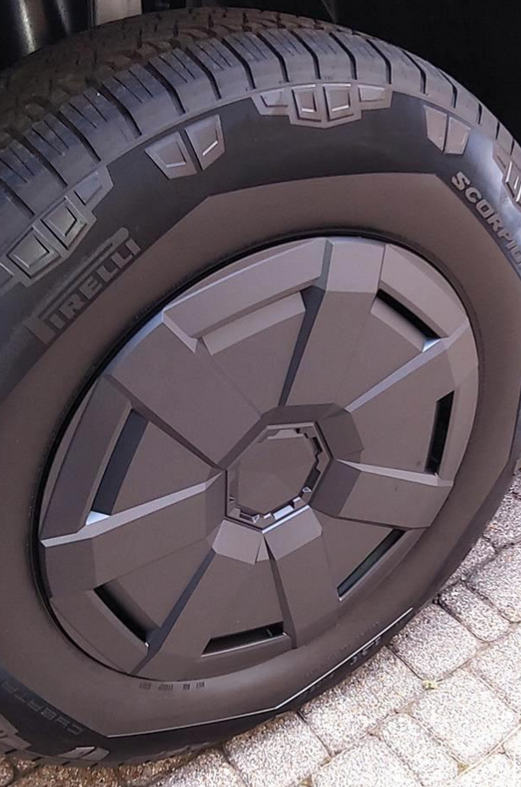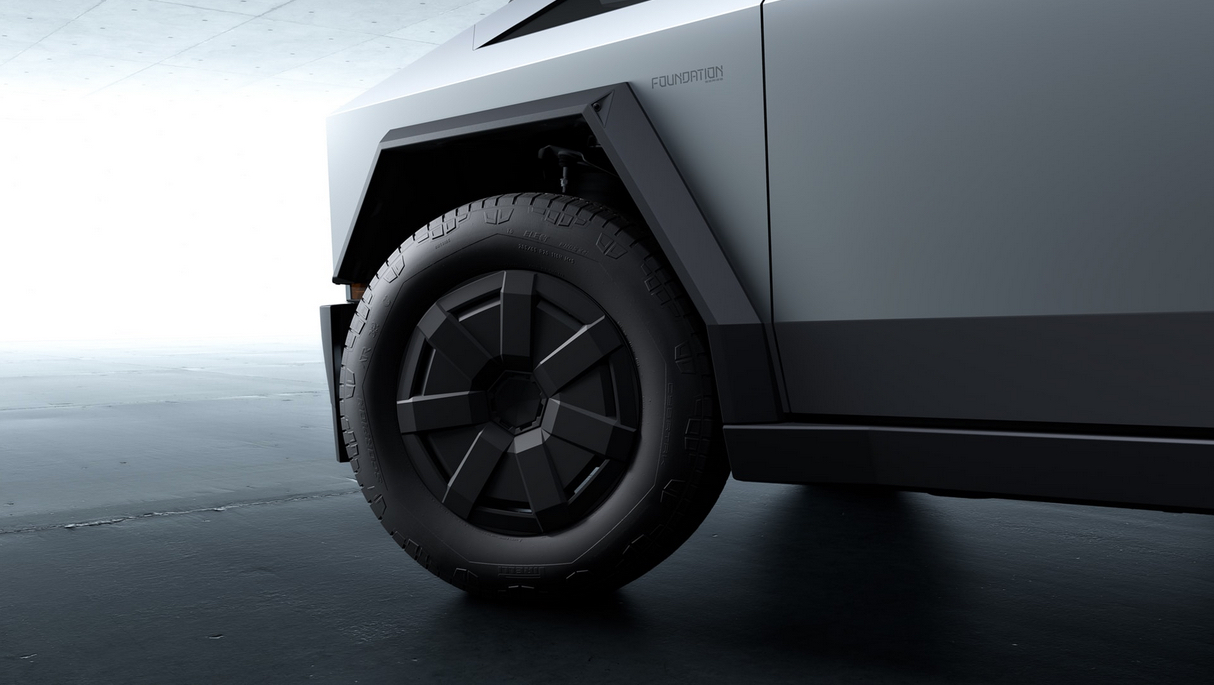One Tesla Cybertruck owner who took delivery this week reported crazy driving efficiency, after notably receiving the electric vehicle (EV) with the new Core Wheels and aero wheel covers.
In a post on the Cybertruck Owners Club forum on Friday, user MadMaxTX shared photos of the newly delivered Cybertruck, adding that the drive home resulted in 304 wH/mile, equating to about 370 miles of range total. On the second drive, the user reported a consumption of 285 wH/mile, which would equate to about 400 miles of range.
“Driving home, consumption was 304 wh/mile! This is around 370 miles on a full charge, mixed city driving, about half freeways,” wrote the user. “Next trip, streets only, light traffic, 97 degrees, BTW, and 285 wh/mile which works out to about 400 miles range.”
Credit: MadMaxTX | CybertruckOwnersClub Credit: MadMaxTX | CybertruckOwnersClub

The driver also questioned whether or not this could be expected regularly with the Tesla Cybertruck, or if the initial drives were simply some kind of fluke.
As can be seen in the user’s photo, the new Core Wheels come with the Pirelli Scorpion ATR tires, which were developed specifically for the Cybertruck and include the word “CYBRTRK” on their outer walls. Tesla launched the Core Wheels option just this week, coming as a more efficient alternative to the company’s normal Cyber wheels included on the dual-motor configuration.
On its website, Tesla estimates that the tri-motor Cyberbeast configuration is rated for up to 301 miles, while the dual-motor AWD trim is rated for about 318 miles of range. With the inclusion of the Core Wheels, which are only available with the AWD configuration, Tesla estimates around 340 miles of range total.
Following our story, Tesla Cybertruck Lead Engineer Wes Morrill also highlighted the fact that it shouldn’t come as too much of a surprise that all-season tires, which are included with the Core Wheels, are more efficient than all-terrains, which come with the Cyber Wheels option. Morrill notes that the tires included with the Core Wheels offer a “custom construction which balances handling and efficiency while also reducing road noise.”
He later responded to continued conversations in the X thread, providing a few more details on the all-terrain versus all-season tires discussion:
Typically All terrain > All-season in snow. That said, a 3-peak rated tire will be best in snow. Tesla will offer a 3-peak winter tire package on the shop for those looking for the best winter performance.
— Wes (@wmorrill3) August 18, 2024
Cybertrucks have recently been spotted in the wild with the new Core Wheels and covers, along with one unit sporting the highly anticipated lightbar alongside the covers and wheels. Tesla also began offering Cybertruck demo drives at select locations in the U.S. and Canada, after launching the EV in the latter country to mark the first Cybertruck sales outside the U.S.
Updated 8/18/24: Added responses from Tesla Cybertruck Lead Engineer Wes Morrill.
Tesla Cybertruck is US’ best-selling vehicle above $100k in July 2024: KBB
What are your thoughts? Let me know at zach@teslarati.com, find me on X at @zacharyvisconti, or send us tips at tips@teslarati.com.

News
Tesla starts showing how FSD will change lives in Europe
Local officials tested the system on narrow country roads and were impressed by FSD’s smooth, human-like driving, with some calling the service a game-changer for everyday life in areas that are far from urban centers.

Tesla has launched Europe’s first public shuttle service using Full Self-Driving (Supervised) in the rural Eifelkreis Bitburg-Prüm region of Germany, demonstrating how the technology can restore independence and mobility for people who struggle with limited transport options.
Local officials tested the system on narrow country roads and were impressed by FSD’s smooth, human-like driving, with some calling the service a game-changer for everyday life in areas that are far from urban centers.
Officials see real impact on rural residents
Arzfeld Mayor Johannes Kuhl and District Administrator Andreas Kruppert personally tested the Tesla shuttle service. This allowed them to see just how well FSD navigated winding lanes and rural roads confidently. Kruppert said, “Autonomous driving sounds like science fiction to many, but we simply see here that it works totally well in rural regions too.” Kuhl, for his part, also noted that FSD “feels like a very experienced driver.”
The pilot complements the area’s “Citizen Bus” program, which provides on-demand rides for elderly residents who can no longer drive themselves. Tesla Europe shared a video of a demonstration of the service, highlighting how FSD gives people their freedom back, even in places where public transport is not as prevalent.
What the Ministry for Economic Affairs and Transport says
Rhineland-Palatinate’s Minister Daniela Schmitt supported the project, praising the collaboration that made this “first of its kind in Europe” possible. As per the ministry, the rural rollout for the service shows FSD’s potential beyond major cities, and it delivers tangible benefits like grocery runs, doctor visits, and social connections for isolated residents.
“Reliable and flexible mobility is especially vital in rural areas. With the launch of a shuttle service using self-driving vehicles (FSD supervised) by Tesla in the Eifelkreis Bitburg-Prüm, an innovative pilot project is now getting underway that complements local community bus services. It is the first project of its kind in Europe.
“The result is a real gain for rural mobility: greater accessibility, more flexibility and tangible benefits for everyday life. A strong signal for innovation, cooperation and future-oriented mobility beyond urban centers,” the ministry wrote in a LinkedIn post.
News
Tesla China quietly posts Robotaxi-related job listing
Tesla China is currently seeking a Low Voltage Electrical Engineer to work on circuit board design for the company’s autonomous vehicles.

Tesla has posted a new job listing in Shanghai explicitly tied to its Robotaxi program, fueling speculation that the company is preparing to launch its dedicated autonomous ride-hailing service in China.
As noted in the listing, Tesla China is currently seeking a Low Voltage Electrical Engineer to work on circuit board design for the company’s autonomous vehicles.
Robotaxi-specific role
The listing, which was shared on social media platform X by industry watcher @tslaming, suggested that Tesla China is looking to fill the role urgently. The job listing itself specifically mentions that the person hired for the role will be working on the Low Voltage Hardware team, which would design the circuit boards that would serve as the nervous system of the Robotaxi.
Key tasks for the role, as indicated in the job listing, include collaboration with PCB layout, firmware, mechanical, program management, and validation teams, among other responsibilities. The role is based in Shanghai.
China Robotaxi launch
China represents a massive potential market for robotaxis, with its dense urban centers and supportive policies in select cities. Tesla has limited permission to roll out FSD in the country, though despite this, its vehicles have been hailed as among the best in the market when it comes to autonomous features. So far, at least, it appears that China supports Tesla’s FSD and Robotaxi rollout.
This was hinted at in November, when Tesla brought the Cybercab to the 8th China International Import Expo (CIIE) in Shanghai, marking the first time that the autonomous two-seater was brought to the Asia-Pacific region. The vehicle, despite not having a release date in China, received a significant amount of interest among the event’s attendees.
Elon Musk
Elon Musk and Tesla AI Director share insights after empty driver seat Robotaxi rides
The executives’ unoccupied tests hint at the rapid progress of Tesla’s unsupervised Robotaxi efforts.

Tesla CEO Elon Musk and AI Director Ashok Elluswamy celebrated Christmas Eve by sharing personal experiences with Robotaxi vehicles that had no safety monitor or occupant in the driver’s seat. Musk described the system’s “perfect driving” around Austin, while Elluswamy posted video from the back seat, calling it “an amazing experience.”
The executives’ unoccupied tests hint at the rapid progress of Tesla’s unsupervised Robotaxi efforts.
Elon and Ashok’s firsthand Robotaxi insights
Prior to Musk and the Tesla AI Director’s posts, sightings of unmanned Teslas navigating public roads were widely shared on social media. One such vehicle was spotted in Austin, Texas, which Elon Musk acknowleged by stating that “Testing is underway with no occupants in the car.”
Based on his Christmas Eve post, Musk seemed to have tested an unmanned Tesla himself. “A Tesla with no safety monitor in the car and me sitting in the passenger seat took me all around Austin on Sunday with perfect driving,” Musk wrote in his post.
Elluswamy responded with a 2-minute video showing himself in the rear of an unmanned Tesla. The video featured the vehicle’s empty front seats, as well as its smooth handling through real-world traffic. He captioned his video with the words, “It’s an amazing experience!”
Towards Unsupervised operations
During an xAI Hackathon earlier this month, Elon Musk mentioned that Tesla owed be removing Safety Monitors from its Robotaxis in Austin in just three weeks. “Unsupervised is pretty much solved at this point. So there will be Tesla Robotaxis operating in Austin with no one in them. Not even anyone in the passenger seat in about three weeks,” he said. Musk echoed similar estimates at the 2025 Annual Shareholder Meeting and the Q3 2025 earnings call.
Considering the insights that were posted Musk and Elluswamy, it does appear that Tesla is working hard towards operating its Robotaxis with no safety monitors. This is quite impressive considering that the service was launched just earlier this year.










